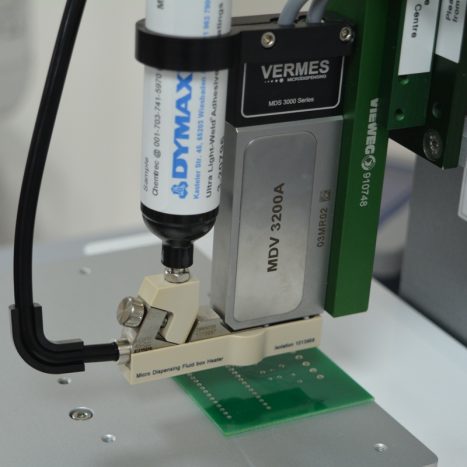Jetting valves enable high-speed, continuous, non-contact dispensing of dots of small size, offering a high degree of accuracy and repeatability. During the jetting process, a small chamber is filled with material and ejected by firing a tappet through the chamber ― using either piezo or high energy pneumatics to achieve very fast tappet movement ― causing the material to exit, or jet, from a nozzle. Here’s a video.
Jetting valves may be useful for dispensing adhesives, greases and oils, and they may also be able to dispense more challenging materials like anaerobic or cyanoacrylate adhesives or filled materials like solder paste. Dependent on the thixotropy, jetting valves can dispense viscosities up to 2,000,000 mPa.s.
One key advantage of jetting valves is that they operate at high speeds of up to 3000 Hz with high accuracy. Volumes can therefore be built up quickly, with very fast, multiple shots. Conventional dispensing valves require a z-axis movement to touch down the liquid onto the surface in order to effect a transfer, with the requisite positional tolerance. Jetting valves deposit the material with no contact, so the positioning requires less movement and is more forgiving of part and tooling tolerances; this also contributes to enhanced process speed. The jetting action can limit material stringing, which otherwise might require special programming in order to apply accurately.
Jetting enables quantities of less than one microlitre (< 1 μl) to be precisely dispensed. The rising miniaturisation of individual components in production processes may demand smaller beads and lines, while maintaining high throughput and consistent reliability and repeatability, and jetting could be considered in this case.
Another advantage of jetting valves is the ability to dispense consistently on substrates with an irregular surface, unusual geometry, or orientation. With a usual dispensing valve, where the material is required to be direct contact with both the needle and the substrate during dispensing, an irregular surface can lead to poor transfer to the surface or damage to the dispensing needle. Jetting technology is also capable of dispensing into grooves and cavities, onto vertical faces, and inside annular rings and tubes.
One example of a jetting valve technology is the new Vermes MDS 1560. Our customers have found success with the valve as it is a simple, flexible, affordable option. It is also a versatile choice, as it can deal with a wide range of viscosities and dispense down to shot sizes of less than 1 nl. The valve can be mounted to dispensing automation or robotics and is simple to set up and adjust.
Enable rapid, precise dispensing even onto irregular surfaces. Come and talk to us about your application.
Categories: dispensing

